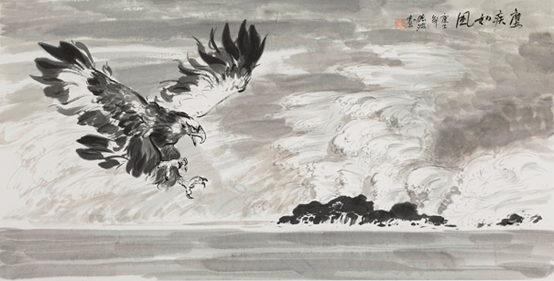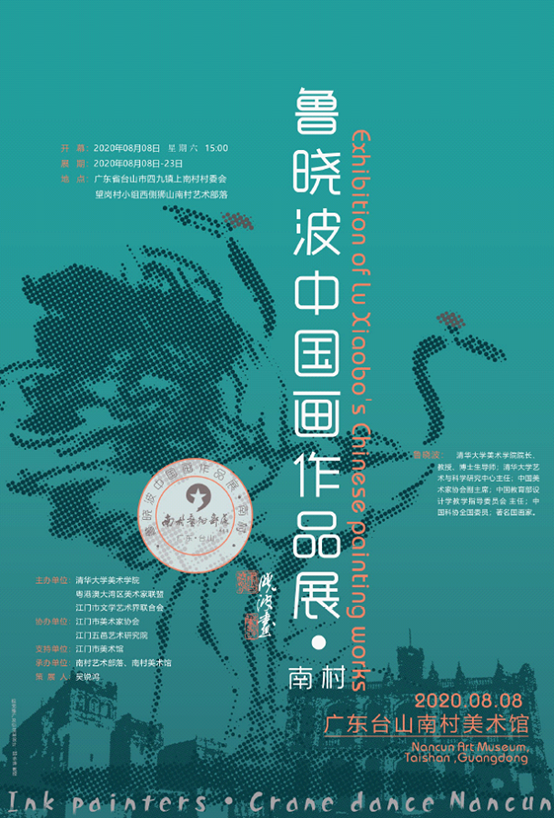On August 8, 2020, the solo art exhibition, titled "Exhibition of Lu Xiaobo's Chinese Painting Works", of Professor Lu Xiaobo, Dean of Academy of Arts & Design, Tsinghua University, was held in Nancun Art Tribe Museum, Taishan, Jiangmen in Guangdong. This exhibition, jointly held by Academy of Arts & Design, Tsinghua University, Artists League of Guangdong-Hong Kong-Macao Greater Bay Area and Municipal Federation of Arts and Literature of Jiangmen, marked the official beginning of the "Second Sketch Cultural Festival in Guangdong-Hong Kong-Macao Greater Bay Area". This festival aimed to significantly promote the construction of Guangdong-Hong Kong-Macao Greater Bay Area, actively integrate cultural and natural resources of the city, enhance cultural communication and integration within the Greater Bay Area and boost the cultural and art industries in this region.
Jiangmen, Guangdong is famous for being home to overseas Chinese, and Taishan in Jiangmen is regarded as the "town of music" and "town of quyi" in Guangdong. The signature architecture, diaolou and western-styled buildings, is scattered across various cities, towns and villages. Several cultural projects have been included into the "first batch of National Intangible Cultural Heritage". It is a crucial city for cultural exchange and communication between the East and West. Professor Lu Xiaobo's art exhibition brought cranes to the south. The dancing cranes in Nancun introduced new aspects of culture to the native town of overseas Chinese.
Lu Xiaobo, Dean and professor of Academy of Arts & Design, Tsinghua University
Lu Xiaobo, a prominent Chinese artist specialized in drawing cranes, is an elegant and cultivated gentleman.
The red-crowned crane, with various profiles and demeanors, reflects Mr. Lu Xiaobo's aesthetic understanding and spiritual pursuit. Through these red-crowned cranes, we could catch a glimpse of his internalized personality and grace, his passion for Chinese traditional culture and his self-disciplinary and constant self-improvement, as well as his persistent pursuit and dedication to truth and beauty.
The crane gains favor of the public not only because it is an embodiment of health and blessing but more importantly because it is associated with the image of freedom, nobility, pride and philosophical tranquility. This is the core spirit symbolized by the crane, the fundamental reason why Chinese scholars have developed a particular interest in it. The crane represents a man of honor who has a noble heart, graceful bearing and extraordinary talents. Mr. Lu Xiaobo is exactly a man like that, a man "as noble and elegant as a crane."
Cats, ink on paper, 69 x 69cm, 2020
This rare exhibition not only manifested Mr. Lu's love for the red-crowned crane over the past 20 years through his artworks but also demonstrated the most passionate and lively side of him as an artist. What made this exhibition valuable was the devotion to and power in his art. From this exhibition, more artists were inspired to improve themselves, pay greater attention to nature and culture, and thereby have a more profound understanding of harmony between nature and mankind through the art of Chinese painting.
Preface to the Art Exhibition
A quote from the notable monk artist Shi Tao in the early Qing Dynasty says, "Art should keep up with the time". This refers to the principle that art should be the pulse of a certain era to reflect and portray that specific period of time. In a globalized society nowadays, integration, development and innovation have, inevitably, become the main themes for contemporary arts. In a modern age where arts increasingly diversify, how to rejuvenate traditional arts and make them valuable in a contemporary setting has become an important mission and subject of study for modern artists.

Cats, ink on paper, 69 x
69cm, 2020
Mr. Lu Xiaobo, without doubt, masters this research subject. He not only has an open mind but also has proficient skills. Instead of confining his works to the field of artistic design, Mr. Lu aims to incorporate both arts and scientific technologies into his paintings as a way of making new interpretations of traditional Chinese paintings in a modern context. He thus makes a great contribution to the innovation and development of contemporary Chinese paintings.
Mr. Lu Xiaobo chooses to portray cranes in traditional Chinese paintings out of his ardent love for traditional Chinese culture. As he was born in Hunan, a pretty and charming province, he tends to "learn from nature". The culturally refined Hunan region, which has produced a large number of eminent scholars and poets, is the place of origin for the Southern school landscape painting founded by Dong Qichang. The bank along the Xiang River, covered with flowers and aquatic plants, interspersed with soaring birds, became the main subject of paintings among these Southern artists.

Eagle Swift as Wind, ink on
paper, 69 x 138cm, 2020
Mr. Lu Xiaobo favors cranes in particular because of its elegant profile, graceful moves and noble characters. The red-crowned cranes painted by him, in various postures, are all so poised, beautiful and proud. They are a vivid reflection of a free, animated living being. Mr. Lu's works, a physical embodiment of Chinese culture, observe the traditions of Chinese freehand brush works, adopt the artistic design typically represented by artists from Academy of Arts & Design, Tsinghua University, and integrate humans, arts and nature seamlessly in one single frame, creating an ideal image of life.
Source: china.org.cn











